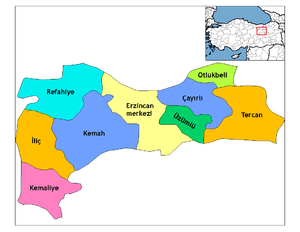Erzincan Province
Erzincan Province (Turkish: Erzincan ili, Kurdish: Parezgêha Erzînganê[2]) is a province in the eastern region of Anatolia, Turkey, and home to eponymous city of Erzincan, its capital. The population was 224,949 in 2010. As the Governor of the province Ali Araslantaş was appointed in 2016.[3]
Erzincan Province Erzincan ili | |
|---|---|
 Location of Erzincan Province in Turkey | |
| Country | Turkey |
| Region | Northeast Anatolia |
| Subregion | Erzurum |
| Government | |
| • Electoral district | Erzincan |
| • Governor | Ali Araslantaş |
| Area | |
| • Total | 11,974 km2 (4,623 sq mi) |
| Population (2018)[1] | |
| • Total | 236,034 |
| • Density | 20/km2 (51/sq mi) |
| • Urban | 114,437 |
| Area code(s) | 0446 |
| Vehicle registration | 24 |
Geography
Erzincan is traversed by the northeasterly line of equal latitude and longitude. It lies on the Northern Anatolian Fault, why it is often the location for earthquakes like one in 27 December 1939[4] and the earthquake on the 13 March 1992.[5]
Districts

Erzincan province is divided into 9 districts (capital district in bold):
History
In September 1935 the third Inspectorate General (Umumi Müfettişlik, UM) was created,[6] into which the Erzincan province was included. Its creation was based on the Law 1164 from June 1927,[6] which was passed in order to Turkefy the population.[7] The Erzincan province was included in this area. The third UM span over the provinces of Erzurum, Artvin, Rize, Trabzon, Kars, Gümüşhane, Erzincan and Ağrı. It was governed by an Inspector General seated in the city of Erzurum.[6] [8] In January 1936, a Fourth Inspectorate-General was established,[9] under which authority the province was transferred. The fourth UM included the provinces of Erzincan, Tunceli, Elazığ and the areas which would become the province of Bingöl.[8] The Fourth UM was governed by a Governor Commander. Most of the employees in the municipalities were to be from the military and the Governor Commander had the authority to evacuate whole villages and resettle them in other areas.[8] The Inspectorates General were dissolved in 1952 during the Government of the Democrat Party.[10]
See also
References
- "Population of provinces by years - 2000-2018". Turkish Statistical Institute. Retrieved 9 March 2019.
- "Li Wan û Erzînganê ji ber berfê rêyên 144 tax û gundan hatin girtin" (in Kurdish). Rûdaw. 3 December 2019. Retrieved 27 April 2020.
- "Valimiz Sayın Ali ARSLANTAŞ". www.erzincan.gov.tr. Retrieved 2020-04-12.
- Rosie Ayliffe, Marc Dubin, John Gawthrop, Terry Richardson, Turkey, 1136 pp., Rough Guides, 2003, ISBN 1-84353-071-6, ISBN 978-1-84353-071-8 (see p.1016)
- Grosser, H.; Baumbach, M.; Berckhemer, H.; Baier, B.; Karahan, A.; Schelle, H.; Krüger, F.; Paulat, A.; Michel, G.; Demirtas, R.; Gencoglu, S. (1998-10-01). [The Erzincan (Turkey) Earthquake of 13 March 1992 and its Aftershock Sequence "The Erzincan (Turkey) Earthquake of 13 March 1992 and its Aftershock Sequence"] Check
|url=value (help). Pure and Applied Geophysics. 152 (3): 465–505. doi:10.1007/s000240050163. ISSN 0033-4553. - "Üçüncü Umumi Müfettişliği'nin Kurulması ve III. Umumî Müfettiş Tahsin Uzer'in Bazı Önemli Faaliyetleri". Dergipark. p. 2. Retrieved 8 April 2020.
- Üngör, Umut. "Young Turk social engineering : mass violence and the nation state in eastern Turkey, 1913- 1950" (PDF). University of Amsterdam. pp. 244–247. Retrieved 8 April 2020.
- Bayir, Derya (2016-04-22). Minorities and Nationalism in Turkish Law. Routledge. pp. 139–141. ISBN 978-1-317-09579-8.
- Cagaptay, Soner (2 May 2006). Islam, Secularism and Nationalism in Modern Turkey: Who is a Turk?. Routledge. pp. 108–110. ISBN 978-1-134-17448-5.
- Fleet, Kate; Kunt, I. Metin; Kasaba, Reşat; Faroqhi, Suraiya (2008-04-17). The Cambridge History of Turkey. Cambridge University Press. p. 343. ISBN 978-0-521-62096-3.
External links
| Wikimedia Commons has media related to Erzincan Province. |
- (in Turkish) Erzincan governor's official website
- (in Turkish) Erzincan municipality's official website
- (in English) Erzincan weather forecast information